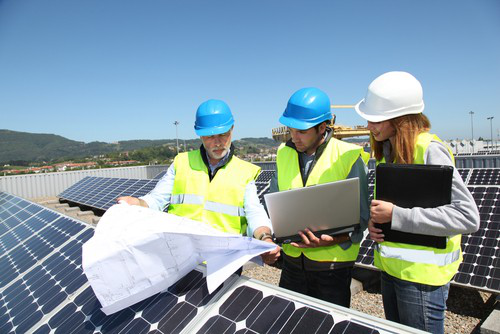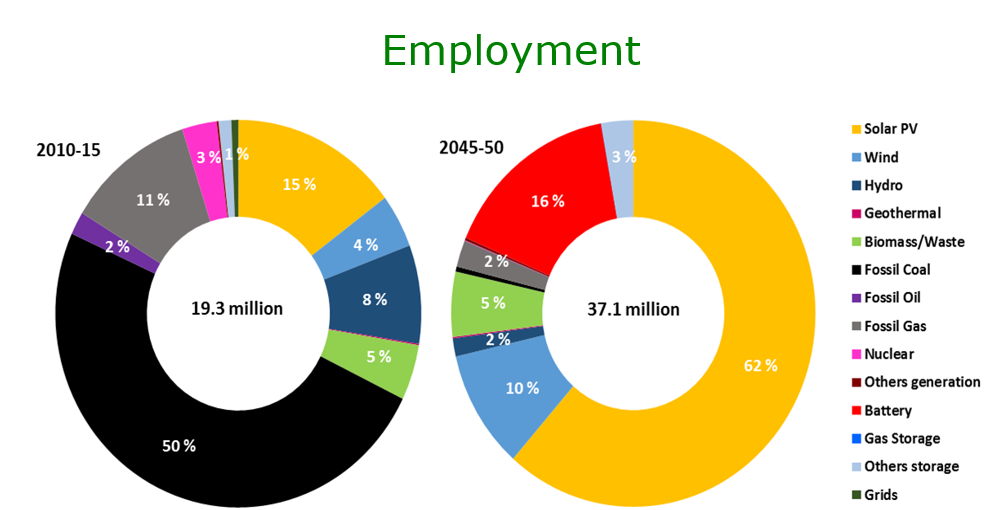中国储能网讯:太阳能和其他能源的结合是未来清洁能源、可再生能源和经济实惠的最佳选择。

根据国际可再生能源机构的报告,太阳能光伏将成为可再生能源领域最大的行业市场。
2016年,可再生能源成为58个新兴经济体中成本最低的电力形式。美国金融咨询和资产管理商Lazard公司今年公布的平衡成本分析报告(LCOE 11.0)显示,太阳能和风能发电成本(每兆瓦时发电46至53美元)低于煤炭和天然气(60-68美元)。
太阳能发电是2016年全球新能源增长最快的电力来源,首次超过其他所有发电形式的增长。据国际能源署(IEA)的调查,在强大的太阳能光伏市场背后,可再生能源增加的电力去年占全球电网新增电力的三分之二。除此之外,到2017年底,太阳能的发电量将超过核电。
东亚地区更环保的电网
今年11月,全球绿色增长研究所(GGGI)在韩国首尔举办了第一次能源论坛,GGGI成员国分享了他们的能源转化经验。德国的太阳能和风能在去年夏天突破了该国所有能源使用量的85%。
迅速增长的可再生能源正在迅速取代德国的核能,而其煤炭在能源结构中仍然起着关键作用。另一方面,在英国,煤炭在能源结构中的使用在短短十年间迅速从50%下降到了9%,取而代之的是廉价的太阳能和海上风能,而其核能仍然起着关键作用。
澳大利亚首都堪培拉迅速实现太阳能和风能投资目标,到2020年将实现其可再生能源为100%的目标,到2030年实现零排放,而其国家层面的目标则更为温和。
在韩国,目前可再生能源只占该国电力生产的2%,其中燃煤电厂和核电厂的发电量分别为40%和30%。但是韩国政府最近表示,在2030年之前把可再生能源发电比例提高到了20%。
韩国政府计划在其全国各地建立可再生能源协调中心,确保每个村庄的太阳能系统,采用地方政府部门领导的项目,其中包括海上风能,可再生能源项目实现公用事业规模可确保可其经济可行性。
实现20%的目标对韩国来说是否有些雄心勃勃,还是为了应对环境和气候的严峻挑战?新政府的双重目标是韩国成为无核社会,同时解决雾霾空气的污染问题,现在韩国相关部门正在积极争论。
实现这两个目标都需要减少核能,以及采用煤和柴油来产生电力。这个确实是一个雄心勃勃,甚至是令人生畏的挑战,但在能源和交通运输部门正在经历非常迅速的过渡时期,这并非不可能完成。
而对于正在进行的能源转型,全球各地的可再生能源和电动汽车发展的速度和深度令人惊讶。这是许多国家政府制定的首要任务,而这正在对传统经济和就业部门造成严重的影响。
而有的国家在公用事业规模的可再生能源拍卖中太阳能和风能的价格创下新低,传统的化石燃料动力能源公司为此付出了沉重代价。例如,德国最大的公用事业公司E.ON公司在上个月的亏损为9亿美元,这是其剩余市值的一半。
难怪可再生能源转型让传统电力企业感到恐慌,各国政府也在考虑是否要保护这些电力企业。
对传统发电厂(特别是煤炭和核电)投资巨大的国家确实需要一大笔资金来收购这些资产。在几年前建成的最廉价的能源形式的燃煤电厂成为能源公司沉重的负担。
在波恩COP23会议上,二十个国家的新建煤电联盟宣布,他们将在2030年之前完全淘汰其能源结构中的煤炭。该联盟希望在2018年联合国气候变化会议之前有五十个成员。
这需要思维方式的真正改变。到2030年,韩国是否能够不采用煤炭发电?目前看来这似乎是不现实的,但请记住,在可再生能源比当今更昂贵的时期,英国也发生了类似的变化。那么为什么不会在韩国发生?
当然有一些挑战。例如,这种能源转型是否会导致更多的失业?在化石燃料行业,尤其是煤炭领域的工作岗位确实正在迅速流失。例如在德国,大部分与煤炭有关的工作已经消失,但与此同时,可再生能源行业创造了更多就业机会。
德国前绿色党议员兼能源观察集团(Energy Watch Group)总裁Hans-Josef Fell表示,到2050年全球能源向100%可再生能源电力系统过渡的过程可以创造3700万个就业机会,从2015年起增长率超过90%。
在快速的技术转型中,确实会失去一些工作岗位,但是更多新的绿色工作岗位正在形成,并需要对劳动力进行教育和再培训,但最终为企业和个人带来了许多新的机会。

预计到2050年,太阳能领域将成为能源行业大部分就业的部门
另一个问题是可再生能源价格太高,这还要取决于公民是否会支持向可再生能源快速转型。在澳大利亚,堪培拉已经承诺了到2020年达成100%的可再生能源目标,引领国家气候变化行动,同时为朝阳产业创造新的就业机会。
在澳大利亚民众的全力支持下,澳大利亚政府正在领导这场绿色科技革命。当澳大利亚首都领地(ACT)政府首次宣布计划在2020年之前立法采购100%可再生能源的目标时,其态度很谨慎。
第一个项目的重点是为学校、教堂、社区中心,以及住宅提供屋顶太阳能补贴。结果,所有的学校和十分之一的家庭屋顶上安装了太阳能。
随后,在全面提升社区意识的同时,ACT政府转向了公用事业规模的风能和太阳能投资,以及采用储能电池稳定电网。澳大利亚大型太阳能的成本在短短几年内就减半了。
虽然引入可再生能源最初确实提高了堪培拉的能源价格,但对其居民的调查显示,随着绿色环保意识的提高,当地居民愿意为可持续能源支付更多的费用。展望未来,堪培拉的能源价格将是澳大利亚最低的。
在其100%可再生能源战略取得成功之后,2016年堪培拉的计划得到进一步发展,致力于在2050年实现净零碳排放。
对于那些无法提供化石燃料和集中式电网的国家,例如大多数非洲国家和太平洋地区的大多数小岛国,其覆盖率低达10%-20%,而可再生能源转型是一个绝佳的机会。
当而其替代方案是价格昂贵的柴油发电,这既可以为电网供电,也可以在停电期间作为备用电源,而太阳能与电池存储相结合已经成为价格最低的能源形式。
这意味着对于非洲和太平洋国家来说,基于“太阳能+电池”的离网或微型电网是一场革命,能带来成本更低的能源,就像不到10年前的手机革命。
像韩国这样已经充分开发传统能源部门的国家,特别具有更多的核能和化石燃料发电厂,其能源转型无疑具有挑战性。
与此同时,韩国还有一些非常显著的优势,比如优异的国家电网、先进的智能电网技术以及全球先进的太阳能电池和电池生产商。在电力中断的时候,人们的观点变化非常迅速。
如2030年韩国实现可再生能源20%这样的目标,目前看起来具有挑战性,但只是其短短五年内朝着正确方向迈出的第一步。
A new world in which solar and storage becomes the cheapest form of energy
By Frank Rijsberman
Friday 15 December 2017
Here’s why a combination of solar power and energy are the best bet for a future energy supply that is clean, renewable, and affordable.
Solar photovoltaic is one of the biggest employers in the renewable energy sector, according to a report by the International renewable Energy Agency. : Image: Shutterstock
Renewable energy became the cheapest form of electricity in 58 emerging economies last year. This year, the 11th Lazard’s Levelized Cost of Energy Analysis (LCOE 11.0) showed that solar and wind energy generation costs (at $46 to $53 per megawatt-hour of generation) easily beat coal and gas (at $60-68).
Solar power was the fastest-growing source of new energy worldwide in 2016, outpacing the growth in all other forms of power generation for the first time. According to the International Energy Agency (IEA), on the back of a strong solar PV market, renewable energy accounted for two-thirds of new power added to the world’s grid last year. In addition to this, solar energy is set to surpass nuclear power by the end of 2017.
A greener grid for East Asia
In November this year, the Global Green Growth Institute (GGGI) organized its first energy forum in Seoul at which GGGI Member countries shared their energy transformation experience. In Germany, on one sunny breezy Sunday last summer, solar and wind broke a record 85 per cent of all energy used in the country.
The rapidly growing renewable energy sector is quickly replacing nuclear energy in Germany – while coal is still playing a key role in the energy mix. In the UK, on the other hand, the use of coal in the energy mix has rapidly fallen from 50 to 9 per cent in just ten years, replaced by cheap solar and offshore wind energy - while nuclear energy is maintaining a key role.
The Australian capital city, Canberra, has rapidly achieved the solar and wind investments to shift to 100 per cent renewable energy by 2020, and is now moving to zero emissions by 2030, while the national targets are much more modest.
In the Republic of Korea, renewable energy currently accounts for just 2 per cent of the country’s electricity production, with coal-fired and nuclear plants generating 40 per cent and 30 per cent, respectively. However, Korea’s new Moon Jae-in government has recently increased the target for the share of renewables in power generation to 20 per cent by 2030.
The Korean government plans to set up a renewable energy coordination center in every region; secure a solar system in each village; adopt projects led by local authorities, including offshore wind turbines; and secure economic feasibility of renewable energy through utility-scale renewable energy projects.
Is the 20 per cent target too ambitious to achieve in Korea – or is it too modest to deal with the environmental and climate challenges? The new government’s twin objectives for Korea to become a nuclear free society while also solving the “fine dust” air pollution problems is now actively debated in Korea.
Doing both requires reducing nuclear energy, as well as the use of coal and diesel fuel for electricity and transportation. Truly an ambitious, even daunting, set of challenges – but not impossible during a time when both the energy and transportation sectors are experiencing very, very rapid transition.
The speed and depth of the ongoing energy transformation, to renewable energy and to electric mobility, is certainly surprising many around the world. It is a top priority for many governments – making and breaking coalitions – and it is causing disruption in traditional sectors of the economy and employment.
As one country after the next sees record breaking low prices for solar and wind in auctions for utility scale renewable energy, the conventional fossil-fuel powered energy companies pay the price. E.ON, Germany’s largest utility, for example, had to write off $9Bn in losses last month, half of its remaining market capitalization.
No wonder the renewable energy transformation scares the conventional power players and has governments consider whether to protect them.
Countries with large investments in conventional power plants – particularly coal and nuclear – do indeed have a big bill to pay for their stranded assets. Coal-fired power plants that were the cheapest form of energy when constructed only a few years ago risk become albatrosses around energy companies’ necks.
In Bonn, at COP23, a new Power-Past-Coal Alliance of twenty countries announced that they will completely phase out coal from their energy mix before 2030. The Alliance hopes to have fifty members before the 2018 UN COP24 climate change conference.
That requires a real change in mindset. Is it imaginable that Korea Powers Past Coal by 2030? It may seem unrealistic today, but remember that a similar change in the UK just happened, over a shorter period, during a time when renewables were more expensive than today. So why not in Korea?
There are some challenges of course. For example, will this energy transition lead to job losses? Jobs are indeed being lost rapidly in the fossil fuel industry, particularly coal. In Germany, for example, most coal related jobs have already been lost – but at the same time, many more jobs were created in the renewable energy industry.
Advertisement
According to Hans-Josef Fell, a former German parliamentarian for the Green party and current President of Energy Watch Group, the global energy transition to a 100 per cent renewable electricity system can create 37 million jobs by 2050, up by more than 90 per cent from 2015.
As in any rapid technology transition, jobs will indeed be lost, but more new, green jobs are being created, requiring education and re-training of the workforce, but ultimately leading to many new opportunities for businesses and individuals.
Solar is expected to make up a majority of jobs in the energy sector by 2050. Image: GGGI
Another question is whether renewable energy is too expensive and whether citizens will support a rapid transition to renewables. In Australia, Canberra has powered forward to 100 per cent renewable energy by 2020, leading national action on climate change while creating new jobs in sunrise industries.
The ACT government is leading this green technology revolution in Australia with the full support of its citizens. When the ACT government first announced its plans to legislate a target of sourcing 100 percent renewable energy by the end of this decade, it was careful to engage the community.
The first programs focused on subsidies for rooftop solar for schools, churches, community centers and residences. As a result, all schools and one home in 10 are now equipped with solar on the roof.
Subsequently, and with full community awareness created, ACT government turned to utility scale wind and solar investments, and batteries to stabilize the grid. The costs of large scale solar in Australia has halved in just a few years.
While the introduction of renewables did indeed initially raise energy prices for Canberra, surveys of residents show that as awareness increased, so did the willingness of the citizens to pay more for sustainable energy. Going forward, the price of energy in Canberra will be among the lowest in the nation.
Following the success of the 100 per cent renewables strategy, in 2016 Canberra went a step further and committed to net zero carbon emissions by 2050.
For countries that could not provide electricity to all their citizens with fossil fuel and a centralized power grid – such as most African countries and most small island states in the Pacific with coverage rates as low as 10-20 per cent – the renewable energy transition is a wonderful opportunity.
When the alternative is expensive diesel-generated electricity, either powering the grid or as back-ups during power outages, solar energy combined with battery storage is already the cheapest form of energy, as documented in Lazard’s 11th levelized cost of energy report that came out last month.
That means that for countries in Africa and the Pacific, off-grid, or mini-grid electricity based on “solar+batteries” is a revolution that can bring affordable energy to all citizens, just like the mobile phone revolution did less than ten years ago.
The energy transition is undoubtedly challenging for countries like the Republic of Korea that have fully developed conventional energy sectors – particularly for the owners and operators of the nuclear and fossil fuel power plants, equipment and machinery.
At the same time, Korea has some very significant advantages, such as an excellent national power grid, advanced smart grid technology, and some of the world’s most advanced producers of solar cells and batteries. During times of disruption our perspectives change very rapidly.
Targets such as the Korean 20 per cent renewables by 2030, that appear so challenging today, will probably be seen as only a first step in the right direction in just five years from now.
Frank Rijsberman is the director-general of the Global Green Growth Institute. This article was written exclusively for Eco-Business.
http://www.eco-business.com/opinion/a-new-world-in-which-solar-and-storage-becomes-the-cheapest-form-of-energy/





